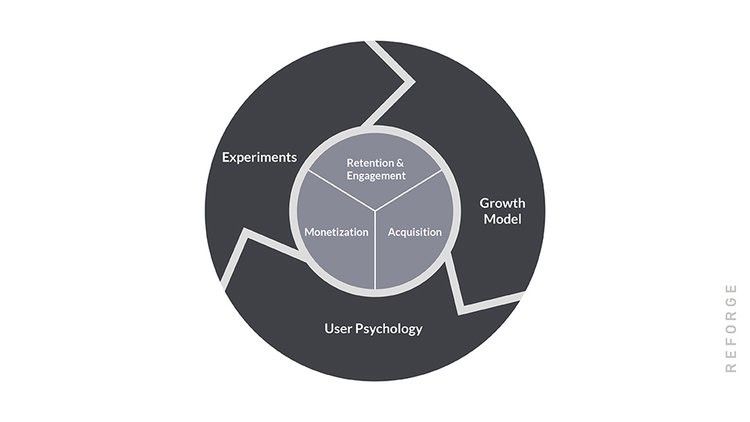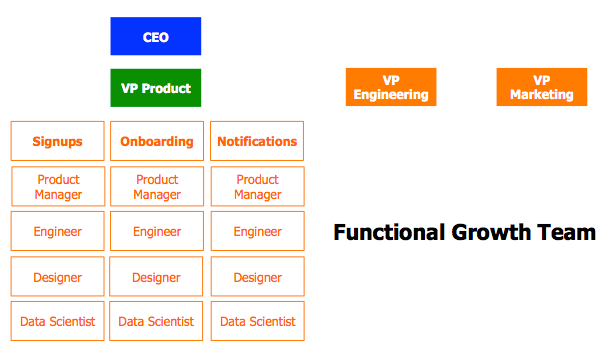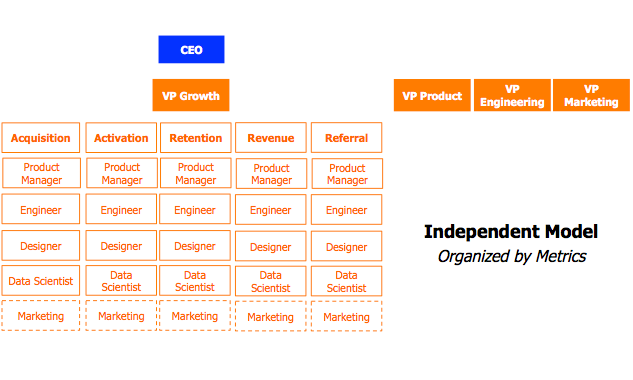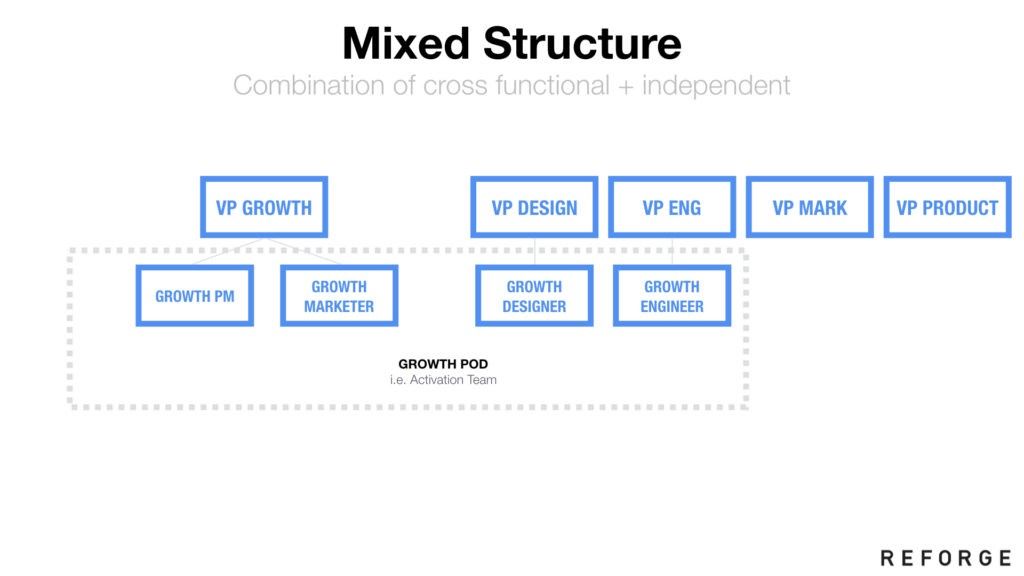How to structure and hire a growth team

If you want to supercharge your startup’s growth, you better bring a growth team on board.
Specialized growth teams have helped big names like Facebook, Uber, and AirBnB attract more customers. However, they’re still somewhat mysterious.
In this article, we’re going to show you how to structure and hire a growth team for your startup.
What Is a Startup Growth Team and Why Do You Need One?
Every company has different departments. From product teams to sales reps, everyone is working hard to create an amazing product and put it in front of as many people as possible.
But here’s the catch: separating departments creates data silos.
Members from individual departments only work with one another. Different departments do not interact. Sales isn’t getting information from product, product doesn’t know what’s happening with customer service.
In the end, we get a mish-mash of conflicting information and no alignment.
The main benefit of having a startup growth team is alignment.
The entire team, composed of different experts (from UX to product designers) work together to grow your startup.
Startup growth teams facilitate quick and smart decision making.
There are no one-sided meetings between different department heads. Everyone knows exactly what needs to be done to supercharge growth.
Finally, as Gregory Ciotti puts it:
“Startup growth is all about outsmarting the competitors.”
When you have different perspectives in one team, you’ll be able to identify your strengths and leverage them to succeed. Every startup is unique, and your growth team can help you leverage your specific positioning to jump-start sustainable growth.
But a journey of a thousand miles begins with a single step.
How to Hire Your Startup’s First Growth Team
Step 1. Evaluate Your Position
There are a few best practice tips for hiring your first growth team:
A. Don’t hire if you haven’t achieved product/market fit.
The general consensus is that you shouldn’t hire a whole team for your growth unless you have established the foundations.
This means having a steady base of paying customers who have identified your product as the perfect solution.
Conversely, if you don’t know what attracts your customers to your products, you won’t be able to grow at a steady rate.
B. Don’t hire if you haven’t identified your customer personas.
Your startup’s main growth asset is your product/market fit. This means understanding your audience, and identifying customer personas.
When your growth team understands the people they need to target, they can do so. If you’re still not sure who your customers are, avoid hiring until you have all the data.
C. Don’t hire if you’re still developing your MVP.
In order to get great results, you need to have a product that your audience already loves. Growth teams primarily focus on improving upon existing features, rather than adding additional ones.
In general, the more constants you have, the better.
Growth teams are here to double-down on what already makes your startup successful.
Step 2. Identify Your Goals
No two startups are alike, and neither are their growth tactics.
Often, startups approach hiring a growth team like they’re hiring a regular departmental team like sales. They look for teams that would fit their organization.
However, the process should be reverse-engineered.
First, start with the goals you want your growth team to accomplish:
- Problems the growth team has to solve
- Missions they have to accomplish
- Areas they will focus on
Then, brainstorm key roles:
- Which roles do you need to achieve the growth goals?
- Which skills do the growth team members need to have?
It’s only when you’ve completed the first two steps that you can look for a way to integrate the growth team into your existing organizational structure.
Again, the sole focus of your growth team is doubling-down on what works, and finding ways to make it work even better.
Step 3. Hire a Product (Growth) Manager
Once you’ve identified your growth model by taking a look at key issues and goals you need to achieve, it’s time to hire “the boss” — the growth lead.
The majority of growth teams have to be cross functional, with people from all areas of business development:
- Marketers
- Product designers
- Engineers
- Data analysts
And more.
However, identifying these roles is firmly in the domain of your product manager (PM).
Your PM should:
- Identify the necessary growth tasks
- Hire people who can complete them
- Communicate with stakeholders
- Monitor growth and strategy
- Evaluate results
- Give feedback and remove obstacles
The authority here should be clear. Your PM will manage different divisions within the team, as well as other departments necessary for growth.
Your growth PM will also create a growth system:
- Growth model and user psych map: Your PM has to evaluate your current strategy and results to create a model with hypotheses. To put it simply, they need to create a course they believe will be most effective.
- Road map: Your growth lead/PM will identify the most important opportunities and experiments that can lead to big growth. For example, they could suggest improving upon some features.
- Processes: Your PM should create processes that the team should follow to achieve goals.
- Hiring: Finally, after identifying strategies and tasks, the PM will hire the right people for the job.

Again, it all starts with your goals. Growth team is not in charge of starting from scratch. They need reliable foundations and results to form hypotheses and launch experiments that will lead to growth.
Yes, there will be plenty of experimenting when growing your startup. However, the experiments have to be scientifically valid. You need constants.
For example, you may know that customers primarily use your product because it streamlines communication with their colleagues.
If you know that, your growth team can expand on additional features serving the same purpose.
Conversely, your growth team wouldn’t focus on making the product appealing to college students. That won’t lead to explosive growth. But doubling down on satisfying the audience that already loves your product will.
Step 4. Hiring a Growth Engineer
The exact roles your growth team will need depend on your startup’s unique positioning. However, growth engineers are pretty universal.
Growth engineers are in charge of implementing the experiments that lead to growth.
So where PMs focus on strategy and communication, growth engineers roll up their sleeves and get to work. PMs deal with strategy, while growth engineers deal with technical implementation.
Growth engineers are in charge of:
- Creating technical strategies
- Implementing strategies and experiments
- Monitoring progress
Just like a regular engineer, a growth engineer has to make all the moving parts flow together seamlessly.
The folks at Free Code Camp offer a great example of product engineer’s responsibilities:
Your growth team is improving the sign-up experience and they want to A/B test two different sign-up experiences. Your growth engineer builds that experience, monitors implementation, and identifies metrics important for evaluating success.
Metrics allow growth engineers to make smart, data-driven decisions.
Without metrics, it’s impossible to know what works well, and what could work even better.
Another important characteristic of efficient growth engineers is pragmatism.
When testing new features or additions, it’s important to roll out the MVP as soon as possible. The first iteration of the feature doesn’t have to be pretty.
In fact, the best growth engineers simply test the functionality, not the presentation.
Only when that aspect is confirmed as desirable do growth engineers follow through with complete development.
Step 5. Hiring a Growth Marketer for Your Startup’s Growth Team
Since existing users and potential users similar to them are the main priority of your growth team, it’s important to hire a growth marketer.
Your growth marketer will communicate new solutions to your customers.
Why is this important?
Firstly, by communicating new solutions properly, your growth marketer ensures your growth team has the necessary number of users to test hypotheses and make data-driven decisions.
They’re not just spokespeople for your startup’s growth team.
They’re the ones “pushing” the experiment so enough people test it, and you get accurate results.
Your growth marketer will look at the previous solutions that have worked for your startup, in order to leverage them for future experiments.
For example, if you’ve had success marketing on Facebook, your growth marketer will identify why that is.
Then, they’ll suggest new tactics to the PM.
Growth marketers’ responsibilities include:
- Analyzing data from previous campaigns
- Analyzing the conversion funnel
- Identifying the most important marketing opportunities
- Developing testing processes and identifying metrics
- Executing communication campaigns
- Achieving customer acquisition goals
In short, growth engineers create and implement solutions. Growth marketers choose the right words that convince (potential) customers.
Step 6. Hiring a Growth Data Analyst
Contemporary growth teams use an incredible amount of data.
Not only will your growth team monitor how customers use your product, but they’ll also monitor engagement rates, customer acquisition costs, and numerous other metrics.
Growth data analysts make sure you see the forest for the trees.
While your growth team should consist of highly analytical individuals, you also need a specialized growth data analyst.
Growth data analysts:
- Analyze data at scale (data from marketing, engineering, etc.)
- Identify opportunities
- Monitor the success of experiments and tactics
If we go back to our sign-up A/B testing example, your growth team could be focusing on the fact that more people are using the new sign-up interface.
However, your data analyst can help you understand why that’s happening.
A data analyst is the only person who can understand circumstances, and spot additional opportunities.
Perhaps more people are clicking on the “Learn more” feature in the new sign-up experience. An analyst could spot that, and forward that insight to marketers, who could then focus on creating additional content to educate users.
Step 7. Hiring a Growth Designer
Finally, growth designers are staples of growth teams because they create the user experience.
If growth marketers communicate solutions to audiences, then growth designers create what the users will see, feel, and use.
Growth designers’ main responsibilities include:
- Analyzing psychological factors
- Developing principles for product design at scale
- Identifying and designing interaction flow
- Monitoring implementation and usage
Growth designers analyze previously successful design principles, identify the most important factors, and then apply them to future experiments.
As such, they can make sure that user experience is perfect fit for testing the validity of new growth solutions.
If the user experience isn’t good, then there’s no way of telling whether your experiments have the potential to be successful.
Let’s look at Dropbox’s example:
Dropbox decided to increase their growth through user acquisition. Their growth designers and growth engineers then worked together to implement a gamified solution. Customers would complete tasks like sharing and inviting their friends in exchange for more storage space.
Dropbox’s growth designers realized that users respond well to gamification. LinkedIn and Google apply the same principles when onboarding users.
It’s not just what you do — it’s how you present it.
Step 8. Choosing Your Growth Team Structure
After you’ve identified the key roles for your growth team, it’s time to assemble it.
Now, the most common question is: Should I have a formal growth team, or simply assemble experts from existing departments?
This is another question that requires you to understand your goals and your growth stage. There is no one-size-fits-all answer. However, there are a few commonly used structures.
If your growth goals are a natural extension of your existing processes and you can easily scale them, consider the functional model like Dropbox and Twitter:

As you can see, these companies clearly outlined their most important growth avenues: signups, onboarding and notifications. Then, they assembled their teams to handle these stages.
The functional growth model is a good option if:
- You know your main growth-driving factors (e.g. signups and onboarding)
- You don’t have a lot of ground to cover, i.e. if you have a relatively simple product
- You want to double-down on the few benefits that attract the majority of customers
However, the functional model can result in lack of growth alignment and focus. Every department has its own leader, and PM’s authority may not be recognized.
There’s also the independent model used by companies like Facebook and Uber:

Uber and Facebook isolated their growth team, and separated them according to different funnel stages.
The independent model is a good option if:
- You want to maximize performance across multiple areas (e.g. every stage of the sales funnel)
- You have a complex product with different benefits
- You want to attract multiple customer personas at once
Of course, the independent model requires more resources.
This is not an option for startups that are still seeking funding. In that case, it’s better to go with the functional model, but retain a razor-sharp focus on the areas that matter.
However, if you’re scaling a huge product with diverse audiences, it’s good to have an independent team that can experiment and monitor progress.
However, it’s important to have a good PM that can break down data silos and facilitate communication across departments.
Finally, there’s also the mixed structure model:

With mixed structure, you have designated growth team members within key departments.
The PM is in charge of communication and making sure the team is aligned.
The main cons of this model are the lack of alignment, and potential priority clashes.
With the mixed structure model, your growth team members have to handle both daily tasks and growth tasks. If you don’t have strong alignment where the daily tasks are the same as growth tasks, there could be problems.
But ultimately, the decision depends on your startup.
Keep your goals in mind, find the right people, and you’ll be well on your way to growth!
No spam, no sharing to third party. Only you and me.
